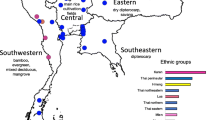Abstract
Tibetan medicine historically has had multiple medical lineages, despite ancient, shared literary medical canons. However, since the second half of the 20th century in Tibet, increasing state control and commoditization has lead to centralization and standardization of Tibetan medicine. Here we investigate how much variation in the use of medicinal plants remains in contemporary Tibetan medicine. Medicinal plants used and/or sold by fifteen Tibetan medical institutions, markets, and doctors, as well as two additional non-Tibetan markets, are inventoried and vouchered (where allowed). The data are ordered by Non-metric Multidimensional Scaling. Four distinct groups are defined: (1) government recognized Tibetan medical institutions and their disciples both in Lhasa and elsewhere, (2) local herbal doctors near Mt. Khawa Karpo, eastern Himalayas, (3) Tibetan medicinal markets in Lhasa and near Mt. Khawa Karpo, and (4) non-Tibetan medicinal markets near Dali and Kunming, Yunnan. This clearly documents the plurality of Tibetan medical traditions—official, local, and market—while differentiating these from non-Tibetan markets.
Similar content being viewed by others
Literature Cited
Anderson, D., J. Salick, R. K. Moseley, and X. K. Ou.2005. Conserving the sacred medicine mountains: A vegetation analysis of Tibetan sacred sites in northwest Yunnan. Biodiversity and Conservation 14:3065–3091.
Beckwith, C.I. 1979. The introduction of Greek medicine into Tibet in the seventh and eighth centuries. Journal of the American Oriental Society 99:297–313.
Cantwell, C. 1995. The Tibetan medical tradition, and Tibetan approaches to healing in the contemporary world. Kailash 17:157–184.
Chinese Academy of Science. 1996. Manual of Tibetan medical materials. Xining Shi, Qinghai, China.
Dash, V.B. 1994. Materia Medica of Tibetan medicine. Sri Satguru Publications, Delhi.
Fischer, A.M. 2005. State growth and social exclusion in Tibet. NIAS Press, Copenhagen.
Gawai Dorje. 1995. Introduction to herbal medicinal plants. Pecin, Tibet.
Ghimire, S., D. McKey, and Y. Aumeeruddy-Thomas. 2005. Heterogeneity in ethnoecological knowledge and management of medicinal plants in the Himalayas of Nepal: Implications for conservation. Ecology and Society 9(3):6. [online] http://www.ecologyandsociety.org/vol9/iss3/art6/
He, J. 2003. Cross-scale institutional linkages of commercial matsutake mushroom management and marketing: A preliminary study of an NTFP in Zhongdian County, Yunnan. Pages 193–197 in J. Xu and S. Mikesell, eds. Landscapes of diversity: Indigenous knowledge, sustainable livelihoods and resource governance in montane mainland Southeast Asia. Yunnan Science and Technology Press, Lijiang, China.
Holliday, I. 2003. Traditional medicines in modern societies: An exploration of integrationist options through East Asian experience. Journal of Medicine and Philosophy 28:373–389
Janes, C. R. 1995. The transformations of Tibetan medicine. Medical Anthropology Quarterly 9:6–39.
—. 1999. The health transition, global modernity and the crisis of traditional medicine: The Tibetan case. Social Science and Medicine 48:1803–1820.
Kala, C.P. 2005. Indigenous uses, population density, and conservation of threatened medicinal plants in protected areas of the Indian Himalayas. Conservation Biology 19:368–378.
Kletter, C., and M. Kriechbaum 2001. Tibetan medicinal plants. CRC Press, New York.
Law, W., and J. Salick (n.d.). Comparing conservation priorities of useful plants: Botanists and Tibetan doctors. Biodiversity and Conservation (submitted).
Li, Y.M., Z. Gao, X. Li, S. Wang, and J. Niemelă. 2000. Illegal wildlife trade in the Himalayan region of China. Biodiversity and Conservation 9:901–918.
Long, C.L., H. Li, O.Y. Zhiqin, X.Y. Yang, Q. Li, and B. Trangmar 2003. Strategies for agrobiodiversity conservation and promotion: A case from Yunnan, China. Biodiversity and Conservation 12:1145–1156.
McCune, B., and M.J. Mefford. 1999. PC-ORD.Multivariate analysis of ecological data, version 4. MjM Software Design, Gleneden Beach, Oregon.
Mittermeier, R. A., N. Myers, J.B. Thomsen, G.A.B. Da Fonseca, and S. Olivieri. 1998. Biodiversity hotspots and major tropical wilderness areas: Approaches to setting conservation priorities. Conservation Biology 12:516–520.
Olsen, C.S., and H.O. Larsen. 2003. Alpine medicinal plant trade and Himalayan mountain livelihood strategies. Geographical Journal 169:243.
—. 2005. Valuation of commercial central Himalayan medicinal plants. Ambio 34:607–610.
— and N. Bhattarai 2005. A typology of economicagents in the Himalayan plant trade. Mountain Research and Development 25:37–43.
Pelto, P. J., and G.H. Pelto. 1975. Intra-cultural diversity: Some theoretical issues. American Ethnologist 2:1–18.
Salick, J., Yang Y.P., and A. Amend. 2005. Tibetan land use and change near Khawa Karpo, eastern Himalayas. Economic Botany 59:312–325.
-. Salick, J., A. Amend, D. Anderson, K. Hoffmeister, B. Gunn, and Z. D. Fang. 2006 Tibetan sacred sites conserve old growth trees in the eastern Himalayas. Biodiversity and Conservation (in press).
Schaeffer, K.R. 2003. Textual scholarship, medical tradition, and Mahay?ana Buddhist ideals in Tibet. Journal of Indian Philosophy 31:621–641.
Silori, C.S., and R. Badola. 2000. Medicinal plant cultivation and sustainable development. Mountain Research and Development 20:272–279.
World Health Organization. 2002. WHO Traditional Medicine Strategy 2002–2005. World Health Organisation, Geneva, http://www.who.int/medicines/publications/traditionalpolicy/en/index.htrnl
Xu, J.C., and A. Wilkes. 2004. Biodiversity impact analysis in northwest Yunnan, southwest China. Biodiversity and Conservation 13:959–983.
Yang, J. S. 1987–89. Diqing Zang yao. Diqing Medicinal plants. Kunming Shi, China.
Yeh, E. 2000. Forest claims, conflicts and commodification: The political ecology of Tibetan mushroomharvesting in Yunnan Province, China. China Quarterly 161:264–278.
Yun, W., I.R. Hall, and L. A. Evans. 1997. Ectomycorrhizal fungi with edible fruiting bodies: Tricholoma matsutake and related fungi. Economic Botany 51(3):311–327.
Zhang, J., W. Wang, and Y. Geng. 2000. A case study on the exploitation and management of NTFP in Shirong Village of Xiaruo Township in Deqin County. Pages 58–67 in The International Seminaron Non-Timber Forest Product. Yunnan University Press, Simao, China.
Author information
Authors and Affiliations
Corresponding authors
Rights and permissions
About this article
Cite this article
Salick, J., Byg, A., Amend, A. et al. Tibetan medicine plurality. Econ Bot 60, 227–253 (2006). https://doi.org/10.1663/0013-0001(2006)60[227:TMP]2.0.CO;2
Received:
Accepted:
Issue Date:
DOI: https://doi.org/10.1663/0013-0001(2006)60[227:TMP]2.0.CO;2




